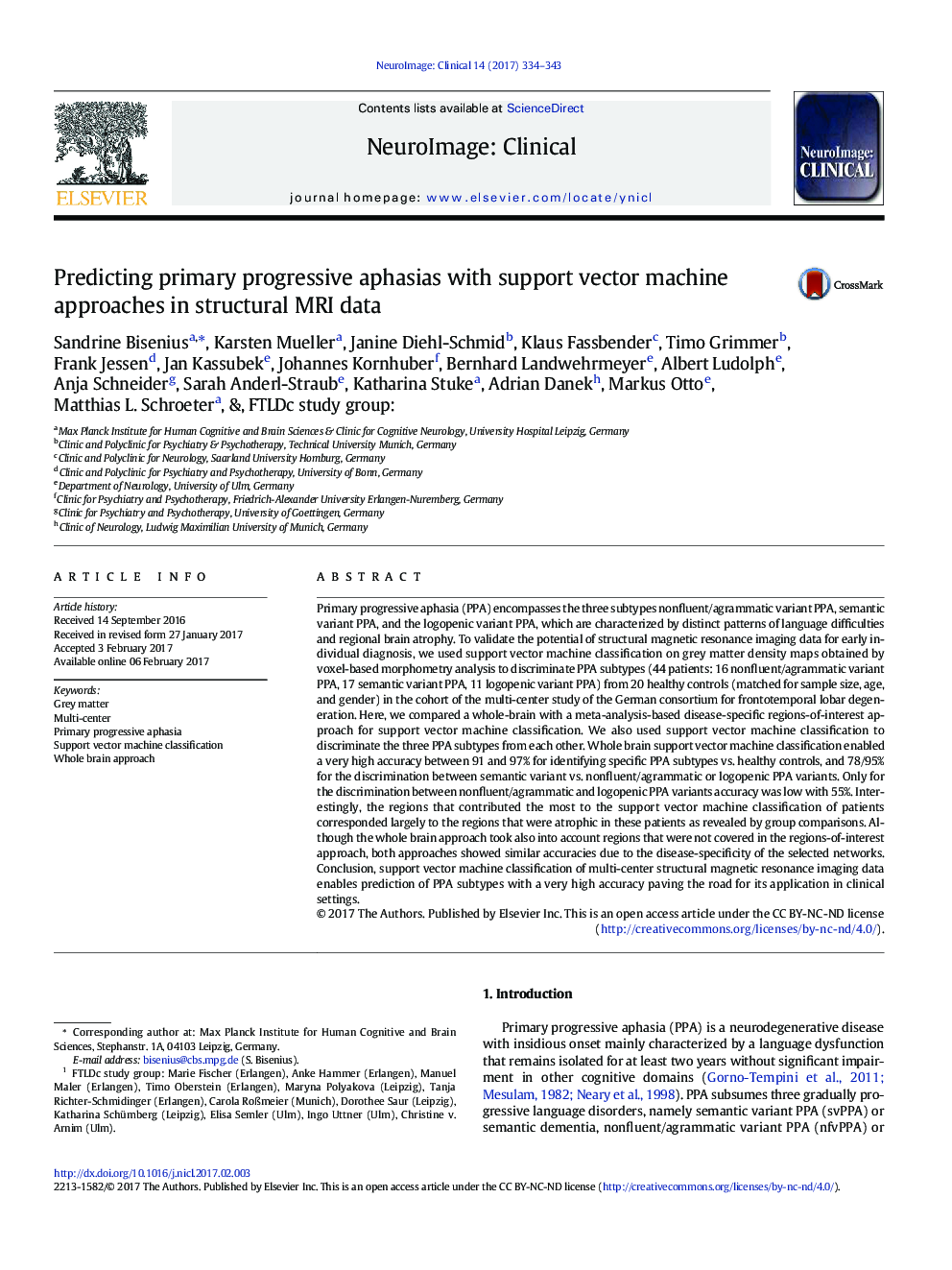| کد مقاله | کد نشریه | سال انتشار | مقاله انگلیسی | نسخه تمام متن |
|---|---|---|---|---|
| 8688668 | 1580953 | 2017 | 10 صفحه PDF | دانلود رایگان |
عنوان انگلیسی مقاله ISI
Predicting primary progressive aphasias with support vector machine approaches in structural MRI data
دانلود مقاله + سفارش ترجمه
دانلود مقاله ISI انگلیسی
رایگان برای ایرانیان
کلمات کلیدی
موضوعات مرتبط
علوم زیستی و بیوفناوری
علم عصب شناسی
روانپزشکی بیولوژیکی
پیش نمایش صفحه اول مقاله

چکیده انگلیسی
Primary progressive aphasia (PPA) encompasses the three subtypes nonfluent/agrammatic variant PPA, semantic variant PPA, and the logopenic variant PPA, which are characterized by distinct patterns of language difficulties and regional brain atrophy. To validate the potential of structural magnetic resonance imaging data for early individual diagnosis, we used support vector machine classification on grey matter density maps obtained by voxel-based morphometry analysis to discriminate PPA subtypes (44 patients: 16 nonfluent/agrammatic variant PPA, 17 semantic variant PPA, 11 logopenic variant PPA) from 20 healthy controls (matched for sample size, age, and gender) in the cohort of the multi-center study of the German consortium for frontotemporal lobar degeneration. Here, we compared a whole-brain with a meta-analysis-based disease-specific regions-of-interest approach for support vector machine classification. We also used support vector machine classification to discriminate the three PPA subtypes from each other. Whole brain support vector machine classification enabled a very high accuracy between 91 and 97% for identifying specific PPA subtypes vs. healthy controls, and 78/95% for the discrimination between semantic variant vs. nonfluent/agrammatic or logopenic PPA variants. Only for the discrimination between nonfluent/agrammatic and logopenic PPA variants accuracy was low with 55%. Interestingly, the regions that contributed the most to the support vector machine classification of patients corresponded largely to the regions that were atrophic in these patients as revealed by group comparisons. Although the whole brain approach took also into account regions that were not covered in the regions-of-interest approach, both approaches showed similar accuracies due to the disease-specificity of the selected networks. Conclusion, support vector machine classification of multi-center structural magnetic resonance imaging data enables prediction of PPA subtypes with a very high accuracy paving the road for its application in clinical settings.
ناشر
Database: Elsevier - ScienceDirect (ساینس دایرکت)
Journal: NeuroImage: Clinical - Volume 14, 2017, Pages 334-343
Journal: NeuroImage: Clinical - Volume 14, 2017, Pages 334-343
نویسندگان
Sandrine Bisenius, Karsten Mueller, Janine Diehl-Schmid, Klaus Fassbender, Timo Grimmer, Frank Jessen, Jan Kassubek, Johannes Kornhuber, Bernhard Landwehrmeyer, Albert Ludolph, Anja Schneider, Sarah Anderl-Straub, Katharina Stuke, Adrian Danek,